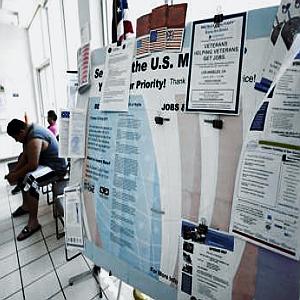 The ‘fiscal cliff’ is much more than a despairing catchphrase tossed around by politicos to describe the budget stalemate in Congress.
The ‘fiscal cliff’ is much more than a despairing catchphrase tossed around by politicos to describe the budget stalemate in Congress.
It is an imminent reality facing many of the unemployed in the Greater Los Angeles area.
If the U.S. Congress and the President fail to work out a plan to avert this so-called ‘fiscal cliff’ before the end of the year, the American public will inherit a weighty package of tax hikes and spending cuts.
According to the Economic Policy Institute, actual impacts from the metaphorical fiscal cliff will result in employment losses reaching 1.6 million jobs by the end of 2013 due to the expiration of the payroll tax cut, emergency unemployment insurance, and other measures. The institute also said that automatic cuts to federal programs, from education to health care to housing, would result in an additional loss of 1.3 million jobs.
The Congressional Budget Office confirmed this dire forecast, saying the cost of going over the cliff will cause the nation to fall back into a recession with a 9.1 percent rise in unemployment by the end of 2013.
Speaking for the concerns of the Golden State, California Treasurer Bill Lockyer said about 40 percent of the federal sequestration impacts, in reference to the automatic spending cuts, are all on state and local government programs. “There’s also the impact on taxpayers if unemployment insurance is suspended, if payroll taxes aren’t cut or tax rates go up … and the unclear possible result of changes in healthcare funding,” Lockyer said.
According to a Dec. 18 statement from the California Employment Development Department, federal extensions of unemployment benefits will come to an abrupt end for an estimated 400,000 Californians (two weeks from the date of the statement) unless Congress and the President take action.
EDD Employment Programs Manager Cesar Valladares said his department is already working to provide the public with information on other sources of relief, such as the Department of Social Services, before individuals run out of unemployment insurance.
“Those 400,000, if Congress doesn’t act, will be affected,” said Valladares. “And because we’ve been here before, and we did this last year, this is not the first time we’ve seen Congress waiting to act.”
According to the department, 85,351 individuals from Los Angeles County received EDD notices in November that their federal extensions for unemployment benefits will end after the week ending Dec. 29.
Those notices also supplied individuals with information on a wide range of alternative forms of assistance from local One-Stop Career Centers, including resume and job search assistance, networking groups, and free training services.
However, these vocational and training programs for out-of-work individuals, which are funded by the Workforce Investment Act and offered at local One-Stop Career and WorkSource centers, are also threatened by the approaching measures of austerity.
California receives approximately $450 million each year in federal funds under the Workforce Investment Act of 1998 to provide vocational services and strategies for adults, laid-off workers, and youth, according to the City of Los Angeles Workforce Investment Board. The purpose of these workforce development activities is to increase participants’ employment, job retention, earnings, and improve their occupational skills.
The Small Business Majority, www.smallbusinessmajority.org, a national business advocacy group, conducted a recent poll of small business owners that cited an alarming concern for local workforce training and assistance programs.
From the 500 small business entrepreneurs polled, 66 percent believed there would be cuts to Workforce Investment Act state grants, thereby severely impacting employment and training services for disadvantaged, underemployed and out-of-work individuals.
The Foothill Workforce Investment Board in Pasadena (which also serves the communities of Arcadia, Duarte, Monrovia, Sierra Madre and South Pasadena), anticipates approximately an 8.5 percent reduction in Workforce Investment Act funding as a result of the federal budget sequestration process, according to Phillip L. Dunn, executive director of the Foothill Workforce Investment Board.
Dunn said the FWIB offers vocational training through public and private training providers by means of Individual Training Accounts. Through this program, workers are given vouchers to use at their discretion at eligible training providers. Before ITAs, workforce counselors prescribed the type of training a worker would receive through public funds.
“If there is a ‘fiscal cliff’ and reduction in funding, FWIB will have to reduce the number of ITAs that it can offer to training and education seekers,” Dunn said.
However, if sequestration goes through, the FWIB’s more immediate concern will be the increased number of unemployment insurance recipients visiting the One-Stop Career Center for employment and training services.
“Typically, these clients are more interested in job development and placement assistance verses training services,” he said. “FWIB and the Employment Development Department will have to balance its services to meet the needs of both the training and job seeking populations.”
Dunn said that the FWIB offers training in many high-demand occupations and high-wage industry sectors, such as clerical, truck driving, IT, and medical assisting. Vocational assistance in these areas is offered from the Foothill Employment and Training Connection, a comprehensive One-Stop Career Center located at 1207 E. Green Street in Pasadena.
“FWIB operates a demand-driven vocational training system, whereby we work closely with employers to obtain workforce intelligence on the types of training needed to meet local labor market needs,” said Dunn, explaining that FWIB’s success is measured by a set of performance standards that include job placement, job retention and increased wage rates.
WorkSource centers, which are also supported through federal funds via the Workforce Investment Act, are a free resource throughout Los Angeles County that connect individuals looking for work with businesses that need help with recruitment.
Expecting future funding cuts to WorkSource centers, the Los Angeles County Workforce Investment Board recently approved a series of reforms to ensure ongoing services are provided to the community.
According to a report published by the L.A. County Workforce Investment Board, the proposed changes call for focusing training, employment services and support to businesses in the following high-growth industries: construction, transportation and logistics, engineering and ‘green’ jobs, health care, biotech, hospitality and tourism, and finance.
To contact the Foothill Workforce Investment Board in Pasadena, call (626) 796-JOBS or visit them online at www.fwibworks.org.
The Central San Gabriel Valley WorkSource Center is located at 11635 East Valley Boulevard, Unit G in El Monte. Call them at (626) 258-0365 or learn more online at www.goodwillsocal.org/employment.

